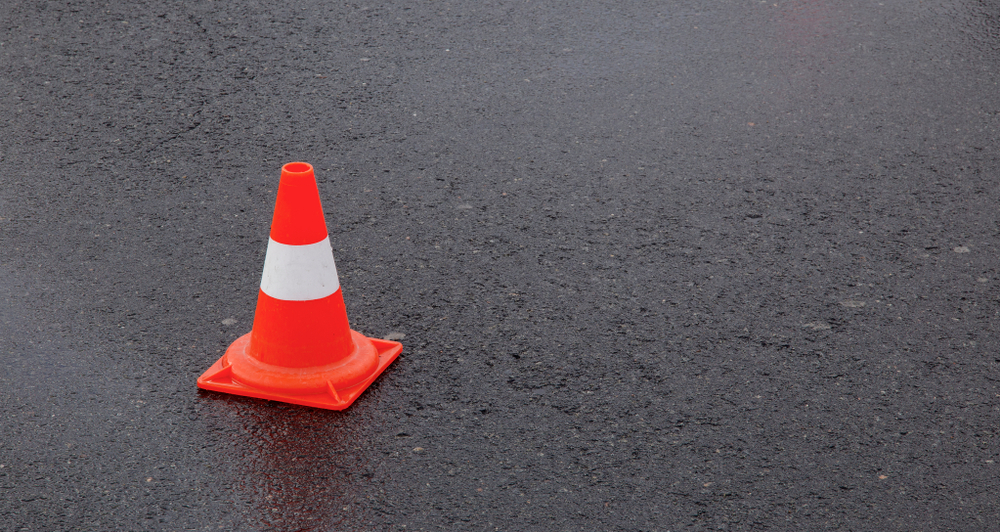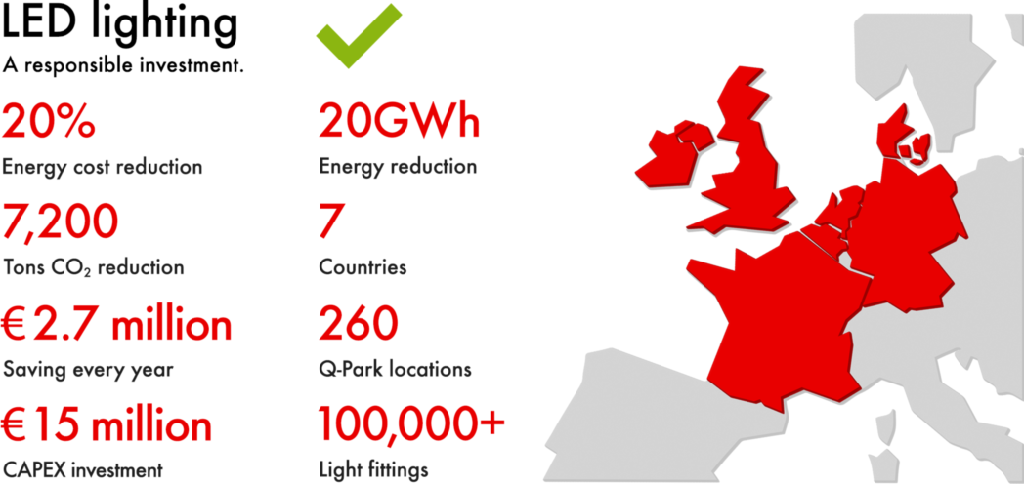Environmental footprint
Q-Park aims to reduce its environmental footprint for all its operations. We express our environmental impact in terms of CO2 emissions per parking space in owned and long-leased facilities.
We manage our environmental impact by reducing energy consumption and by introducing energy-saving technology such as LED lighting with smart switching controls in our parking facilities.
Our lighting systems switch to brighter lighting when movement of cars or pedestrians is detected. In addition, when no cars are present in part of the car park, lighting is automatically dimmed to emergency levels.
We also take simple operational measures to increase the efficiency of our parking facilities. For example, in quiet periods, we temporarily close off parking decks until the number of available spaces on the decks in use reach a certain minimum. We can do this simply by placing traffic cones in the entrance.
Figure 17 Simple operational measures to increase energy efficiency - a traffic cone

Emissions
Q-Park wants to contribute to lowering CO2 emissions of other harmful substances, and to reducing particulate matter. Reducing emissions contributes to the general quality of life, and that in urban areas in particular.
Results
At Q-Park, in 2018 we again reduced our carbon footprint per parking space in owned and long-leased parking facilities by 21% compared to 2017. This considerable reduction can be attributed to our LED programme and operational measures designed to increase overall efficiency.
Note
The carbon intensity of EU electricity production decreases every year due to the increased role of renewable electricity and increased transformation efficiencies. Of the countries in which Q-Park operates we see an impressive decrease of carbon intensity in electricity production in the UK, France, Denmark, Norway and Finland. So where as the average decrease of kWh usage per owned and long-leased parking space is 12%, the average carbon footprint reduction is 21%.
The increase of direct energy consumption and Scope 1 emissions is mainly due to an increase in kilometres driven by car in the UK, France and Denmark.
Chart 7 Greenhouse gas emissions (GHG) in tons CO2
Chart 8 Carbon footprint (kg) per parking space per type of structure
Our car fleet
We endeavour to take specific measures to reduce the negative impact that our own operating activities have on the environment. Our car fleet is slowly changing as we replace diesel cars at the end of their useful life span. In the coming year, as lease car contracts expire, we expect a considerable reduction in the number of petrol cars in our fleet as well.
Results
In 2018 we reduced the number of diesel cars in our fleet by 20 and increased the number of all electric cars by one, so we now have 71 e-cars.
Chart 9 Car fleet
Energy efficiency
Q-Park is a large consumer of electricity, both for lighting and operational equipment, as well as for charging electric cars. We have an energy-saving programme in place to implement measures for reducing energy consumption.
The Q-Park energy-saving programme is demonstrating clear benefits – in financial terms as well as in our environmental impact. We procure our energy on a larger scale by means of a central purchasing policy and have operational action plans to consume fewer kWh ourselves.
Results
In 2018 the total amount of energy, measured in GWh, that we consumed in our owned and long-leased parking facilities decreased by 2%.
Chart 7 Total GWh consumed by owned and long-leased parking facilities
LED transformation project
LED projectIn 2018 Q-Park gave impetus to its LED transformation project to accelerate the transformation to energy efficient LED lighting in parking facilities. It's thought to be the largest project of its kind in Europe.
To ensure that its parking facilities take full advantage of the latest energy-saving technologies, Q-Park is partnering with Future Energy Solutions (FES) to install state-of-the-art LED lighting in its parking facilities.
The project is being simultaneously rolled out across the Netherlands (72 sites), Germany (32 sites), France (50 sites), Belgium (22 sites), United Kingdom (47 sites), Ireland (10 sites) and Denmark (15 sites). This ambitious project will be complete by December 2019, bringing forward the considerable savings.
The huge investment, exceeding EUR 15 million, going into this LED transformation project will add more than 260 locations to the ±100 parking facilities already fitted with energy-saving lighting in the period 2013–2016.
Because of the scale of this project, Q-Park can specify criteria light fittings and every single LED. This ranges from manufacturing, installation and maintenance. We require durable, consistent quality lighting with a long warranty of at least 10 years on every lighting product we use. We have specified differing lighting levels for different purposes in the various areas within a parking facility.
We have specified our lighting requirements to meet or exceed statutory requirements as follows:
85 lux - parking spaces, driving aisles
100 lux - staircases, lift lobbies, toilets
200 lux - parking equipment areas
300 lux - payment areas
75 lux (night time) and 300 lux (day time) - transition light at car access and exit areas to allow motorists time to adjust their eyes to differences in light levels
Kelvin light colour temperature - 4,000K
Figure 17 LED transformation project - infographic

The project will be completed by December 2019, bringing forward the benefits and savings.
Win-Win for all
By the end of 2019, a significant proportion of the purpose-built parking facilities in our portfolio will consume less energy compared to 2018. In this way, we contribute to the aims of the Paris Agreement, which set ambitious targets for reductions in carbon emissions.
Results
Energy consumption is expected to drop by more than 20%, equivalent to more than EUR 2.7 million, accompanied by a carbon footprint reduction of more than 7,200 tonnes of CO2 per year. These savings are cumulative, so by 2025 Q-Park will have saved more than 140 GWh of electricity, equivalent to more than 50,000 tonnes of CO2.
In addition to more than 65% energy savings using LED lighting, installing smart lighting controls will contribute to an extra 10% energy reduction. This project means a major financial and environmental benefit for current and future Q-Park stakeholders and portfolio partners: Project developers and Public & Private Landlords.
Due to its scale, Q-Park has negotiated a 40% reduction on cost per light product. By December 2019, the lighting experience at 260 parking facilities will have been transformed with more than 100,000 installed LED luminaries.
Click here for our LED Showcase.
Figure 18 LED transformation project - transitional light at car access and exit points

